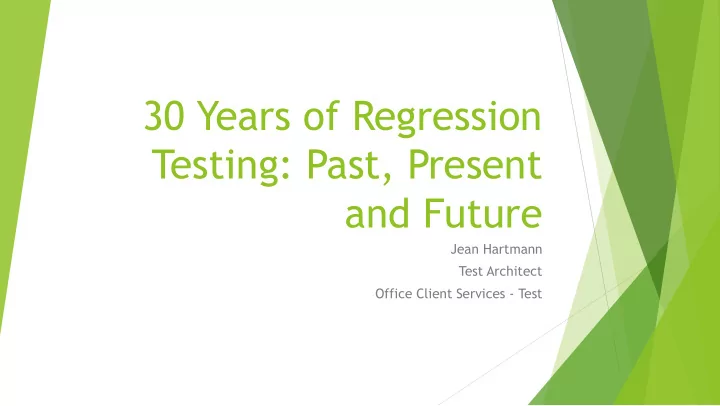

30 Years of Regression Testing: Past, Present and Future Jean Hartmann Test Architect Office Client Services - Test
What is Regression Testing? From Wikipedia: “ Software testing that seeks to uncover new software bugs or regressions in existing functional and non-functional areas of a system after changes, such as enhancements, patches or configuration changes, have been made to them. The intent of regression testing is to ensure that a change, such as a bug fix, did not introduce new faults. One of the main reasons for regression testing is to determine whether a change in one part of the software affects other parts of the software ”.
30 (or More) Years Ago … 1972 – Appears in papers at 1 st software testing conference 1970s-1980s – Becomes mainstream, appears in classic reference text Since 1980s – Interest from academia and industry Today, more useful than ever…
Regression Testing Strategies Retest-all – re-running entire test suite to ensure no regressions Costly in terms of test execution and failure analysis Regression test selection (or selective revalidation) – re- running subset of tests for less cost and with same bug detection capability as retest-all strategy Let’s take a look at regression testing and what has impacted it over the decades…
Major Industry Trends and Their Impact Hardware Mainframes and mini-computers to desktop PCs and Sun (SPARC) workstations Software Assembler to procedural and object-oriented languages Testing Manual (error-prone) to automated (repeatable) Impact on regression testing Code base and number of automated tests is growing Test execution is now on demand Test passes still taking a long time!
1980’s: Genesis Early 1980’s, Kurt Fischer proposed a mathematical approach Based on operations research, specifically integer programming models Goal - select an optimal (minimal) set of regression tests Code coverage data to build the model Mathematical solver to solve model – did not scale well at the time
1980’s: Data flow -based Testing Much publicized, academic testing approach Based on static code analysis to compute so- called def-use (DU) pairs Goal – select tests based on changes to code variables (ripple effect) Suffered from limitations of static code analysis Costly to compute Interprocedural analysis was approximate Feasibility of def-use pairs? http://www.inf.ed.ac.uk/teaching/courses/st /2011-12/Resource-folder/young- slides/PezzeYoung-Ch13-DFTest.pdf
1990’s: Putting Theory into Practice Researchers realize tools were needed to demonstrate and reap benefits Active collaborations between academia and industrial research labs Spawned multi-million dollar tool development efforts Tactic @ Siemens ATAC @ Bellcore/Telcordia TestTube @ AT&T Bell Labs Tools enabled larger empirical studies to be conducted Studies successful and well-publicized …But, the issue was still adoption by business units!
2000’s: Large -Scale Application Large-scale application required research talent, domain expertise AND resources Magellan toolset is a mature, widely-used toolset within Microsoft Includes code coverage, code churn and test selection technology Windows Sustained Engineering (WinSE) Based on Fischer’s approach Achieving significant reductions in tests for rerun http://www.cs.umd.edu/~atif/Teaching/Fa ll2002/StudentSlides/Cyntrica.pdf
2010’s and Beyond: Mobile and Online Services Until Today… Mostly shrink-wrapped products, packaged and delivered on CDs/DVDs Development lifecycles have been extensive, e.g. three years for new Office release Post-checkin regression testing Large, regular test passes to validate breadth and depth of product at regular milestones Process owned by Test Tomorrow… Shift towards more upstream quality and quicker deployment cycles Driven by mobile and online service demands Pre-checkin regression testing On-demand, focused unit/component testing Process owned by Dev
A Story with A Twist: Integrated Circuit Testing IC or integrated circuits are extensively tested Large numbers of test vectors generated as part of a testbench (or test suite) Used to validate behavioral code written in VHDL or Verilog Goal is to reduce execution time (in simulator) Example of a software technique being applied to hardware problem
Do-It-Yourself : Regression Test Selection Tools Ingredients Code coverage tool that can generate trace data Code churn tool that can identify code changes Test selection tool or integer programming model solver Method Run your tests against your instrumented product code or covbuild 1. Identify two product builds and run code churn tool against the code 2. Input coverage and churn data into test selection tool to generate subset of tests 3. Result Subset of regression tests that exercise the changed portions of product (or not) Hook up to test case management (TCM) tool for automatic test execution
Summary Chronicled the journey of regression test selection over the past thirty years Highlighted some of the major milestones in its development Examined how major industry trends have influenced it Provided thought on how to apply it in your organization
Recommend
More recommend